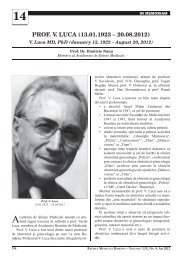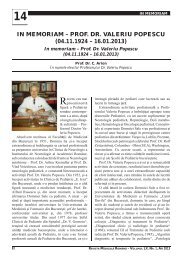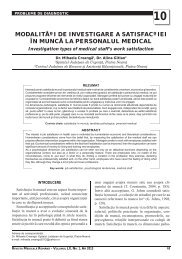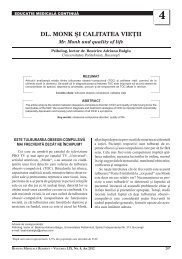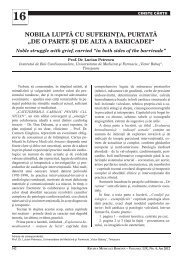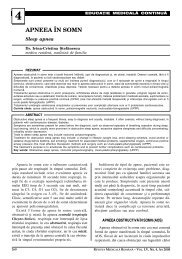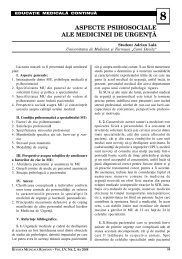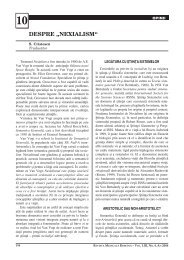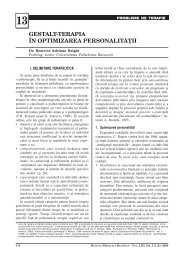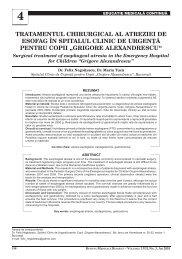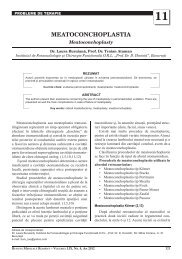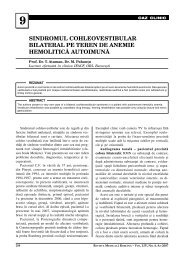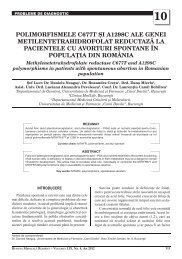Create successful ePaper yourself
Turn your PDF publications into a flip-book with our unique Google optimized e-Paper software.
114<br />
posibile care stau la baza lor şi de a recomanda<br />
modul de monitorizare şi gestionare a efectelor<br />
secundare iat<strong>ro</strong>gene.<br />
Metode<br />
Am identifi cat publicaţiile relevante, printr-o<br />
căutare pe www.sciencedirect.com, între anii 2004-<br />
2012, folosind cuvinte cheie: antipsihotice, antipsihotice<br />
atipice, denumirea individuală a antipsiho<br />
ticului, diabet zaharat, hiperglicemie, obezitate,<br />
sin d<strong>ro</strong>m metabolic, şi am rezumat studiile cheie din<br />
această literatură.<br />
Rezultate<br />
Deşi antipsihoticele sunt piatra de temelie a<br />
tratamentului pentru mai multe boli psihice, aceste<br />
<st<strong>ro</strong>ng>medica</st<strong>ro</strong>ng>mente se asociază în mod semnifi cativ cu<br />
risc crescut de obezitate şi boli cardiovasculare.<br />
Antipsihoticele de generaţia a doua prezintă<br />
riscuri diferite de a p<strong>ro</strong>duce creşterea în greutate şi<br />
alte tulburări metabolice: clozapina şi olanzapina<br />
au riscul cel mai ridicat, quatiapina şi risperidona<br />
un risc moderat, aripiprazolul, amisulprida şi<br />
ziprasidona cel mai redus risc.<br />
Este difi cil de determinat dacă prevalenţa tulburărilor<br />
metabolice este crescută în această populaţie<br />
independent de tratamentul antipsihotic, deoarece<br />
schizofrenia a fost asociată cu diabet zaharat şi tulburări<br />
ale metabolismului glucidic încă înainte de<br />
int<strong>ro</strong>ducerea <st<strong>ro</strong>ng>medica</st<strong>ro</strong>ng>ţiei antipsihotice. Un risc<br />
crescut de diabet zaharat sau scăderea toleranţei la<br />
glucoză la rudele de gradul întâi ale pacienţilor cu<br />
schizofrenie sugerează un <strong>ro</strong>l genetic în relaţia<br />
dintre schizofrenie şi tulburările metabolice.<br />
Unele efecte adverse metabolice au fost corelate<br />
cu afi nităţile pentru neu<strong>ro</strong>transmiţători, şi anume<br />
pentru receptorii: se<strong>ro</strong>toninergici 5-HT2C şi 5-HT1<br />
A, dopaminergici D2, histaminergici H1,α adrenergici<br />
şi muscarinici M<st<strong>ro</strong>ng>3.</st<strong>ro</strong>ng><br />
În plus, antipsihoticele pot modifi ca homeostazia<br />
glucozei prin creşterea secreţiei de insulină.<br />
Caracteristicile individuale ale pacienţilor care<br />
pot predispune la tulburări metabolice includ vârsta<br />
tânără (copii şi adolescenţi), sexul feminin, prima<br />
utilizare a antipsihoticelor, durata lungă a trata mentului,<br />
răspuns clinic bun, indicele de masă cor porală<br />
parental, indicele de masă corporală mare înainte<br />
de primul tratament antipsihotic.<br />
Concluzie<br />
Multe studii au confi rmat potenţialul <st<strong>ro</strong>ng>medica</st<strong>ro</strong>ng>mentelor<br />
antipsihotice de a p<strong>ro</strong>duce sau a declanşa<br />
dereglări metabolice, dar mecanismele farmacologice<br />
care stau la baza asocierii lor cu anomalii<br />
metabolice rămân neclare.<br />
REVISTA MEDICALÅ ROMÂNÅ – VOLUMUL LIX, NR. 2, An 2012<br />
Ultrastructural aspects for understanding<br />
adipogenesis and adipose ti ssue dysfuncti on<br />
related to obesity<br />
G.-V. Mirancea 1 , B. Smeu 2 , A.-M. Mo<strong>ro</strong>sanu 3 ,<br />
C. Copaescu 4 , N. Mirancea 3 , I. Popescu 4 ,<br />
S. Carniciu 5 , C. Ionescu-Tirgoviste 5<br />
1 “Ca<strong>ro</strong>l Davila” University of Medicine and Pharmacy,<br />
Bucharest, Romania<br />
2 “Delta” Hospital, Bucharest, Romania<br />
3 Insti tute of Biology, Bucharest, Romanian Academy<br />
4 Fundeni Clinical Insti tute, Bucharest, Romania<br />
5 Nati onal Insti tute of Diabetes, Nutriti on and Metabolic<br />
Diseases “N.C. Paulescu” Bucharest, Romania<br />
The major <strong>ro</strong>le of the adipose tissue is to store<br />
energy. Human body has two distinct types of fatstoring<br />
tissues: (1) b<strong>ro</strong>wn adipose tissue (BAT) represented<br />
by adipocytes with multilocular lipid<br />
d<strong>ro</strong>plets and (2) white adipose tissue (WAT) represented<br />
by adipocytes, each with a unilocular huge<br />
lipid d<strong>ro</strong>plet, functioning as a secretory organ that<br />
releases soluble factors, known as adipokines involved<br />
in regulation of some physiological p<strong>ro</strong>cesses.<br />
Irrespective of body location, adipose tissue<br />
consists of (1) mature adipocytes (M A), (2) endothelial<br />
cells and associated pericytes, (3) nerves<br />
and (4) other st<strong>ro</strong>mal cells, which all are sur<strong>ro</strong>unded<br />
by (5) extracellular matrix, mainly represented<br />
by different species of molecules (a) fi brillar organized,<br />
(b) as basement membranes components or<br />
(c) soluble molecules. Mention must be made that,<br />
in some circumstances, inside of st<strong>ro</strong>mal spaces<br />
mainly located between adipocytes, infl ammatory<br />
cells as extravasated cells – for ex. granulocytes,<br />
mac<strong>ro</strong>phages – can be detected. Perturbations in<br />
body energy balance by limitation of the adipose<br />
tissue amount or an excess of adipose tissue (obesity)<br />
lead to severe dysfunctions and disease. In our<br />
days, because of w<strong>ro</strong>ng diet rich in glucose and fat,<br />
as well as of the adopted abnormal life style, a lot<br />
of people are affected by obesity. The obesity and<br />
its related diseases, including cancer initiation and<br />
p<strong>ro</strong>gression, are increasing, being one of the major<br />
causes of morbidity and mortality in developed<br />
countries. That is why there is a great need and interest<br />
to study the factors and subtle mechanisms<br />
involved in excessive accumulation of adipose tissue<br />
in the human body.<br />
One major question arises: what is the real explanation<br />
for the body mass/weight increasing by<br />
adipose tissue accumulation during obese adult<br />
life? Does human body need new adipocytes – as



